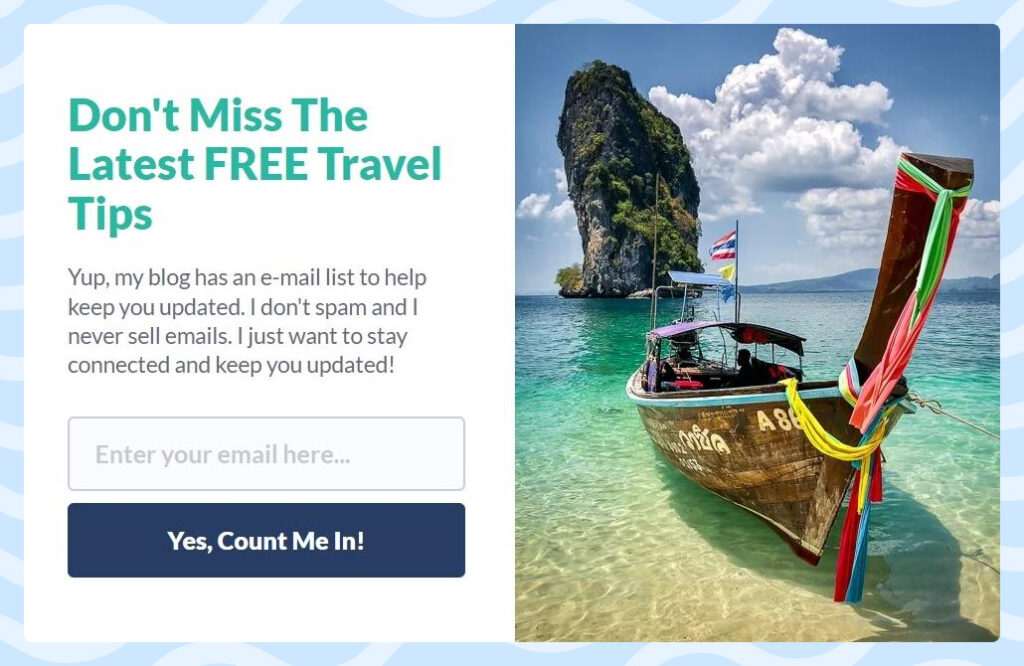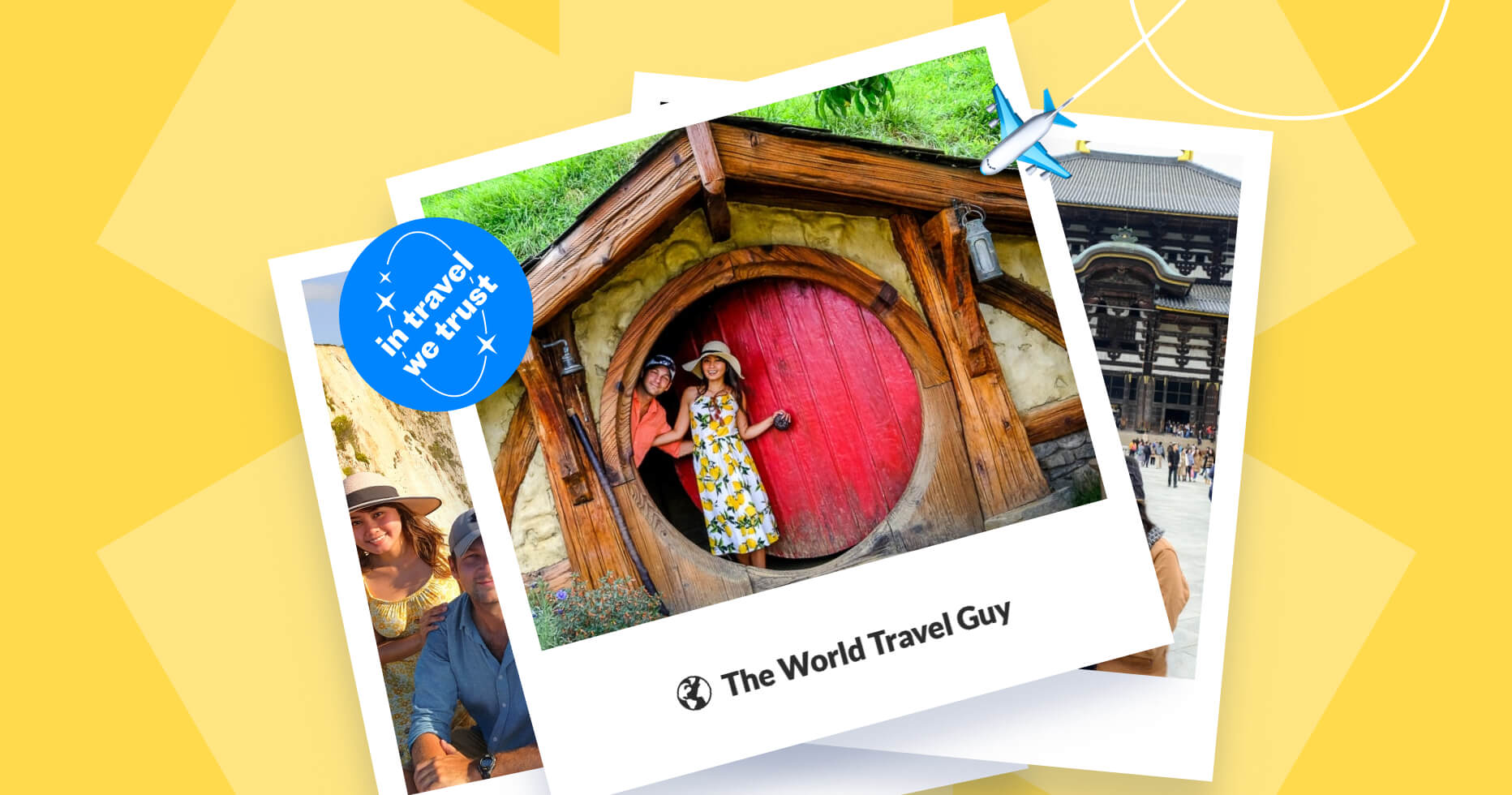How It All Began

I first fell in love with travel on a trip to Colorado in 2015. Then, after several years of overseas experiences, I started my travel blog in 2019 to document my own travels and try to help others explore foreign countries on a budget.
It was originally a solo travel blog, but now it’s becoming more of a couple travel blog. I’m sure, someday, when we have kids, we’ll cover our family travels as well!
I’m an American currently based in Bali, Indonesia, where I met my wife Intan (a Bali local). Now, we travel the world together and try to document the most scenic destinations by creating articles, photos, videos, and guides for other travelers.
We go on all kinds of hikes, visit beaches, waterfalls, volcanoes, castles, temples, and monuments, and see wildlife and many other interesting sights.
Our Travel Style

We’ve been blessed with some amazing experiences in our travels around the world, including completing a fair number of bucket list items like Angkor Wat, the Taj Mahal, Angels Landing, and some amazing Utah hikes.
Our favorite continent to explore is Asia, and we especially enjoy tropical islands for the sun and warm weather. As a result, we’re usually traveling in Southeast Asia, in beautiful and affordable places like El Nido Palawan in the Philippines.

More recently, we’ve been trying to branch out and cover new countries on our blog in order to help diversify our content. We just visited Zakynthos Greece and Maya Bay in Thailand. Earlier this year, we went to Machu Picchu in Peru.
Even though we prefer to travel in tropical Asian countries, and even though it’s smart to focus on a special niche, I also think it’s a good idea to have a wider range of content so your travel blog will be interesting for a bigger audience around the world.
Traffic
My travel blog is attracting almost 200,000 monthly page views according to Google Analytics, and more than 230,000 according to SEMrush. That number is steadily increasing as I write more content. The majority of my traffic is organic from Google.

You can monitor your website traffic with Google Analytics and SEMrush, along with plenty of other tools out there. Some of these tools also allow you to estimate the dollar value of keyword traffic, although I haven’t found the estimates to be exact all of the time.
How I Grow Traffic
To grow my traffic, I focus on writing high-quality content, building good backlinks from authoritative websites, and studying keywords using sites like Moz and SEMrush.
It can be pretty difficult starting out as a blogger because most keywords have already been covered hundreds (or thousands) of times by other travel blogs before you. In addition, the number of competitors is growing every day. To unseat your competition, you will need high-quality content with great photos and lots of detail. Try to write guides that other sites will be proud to link to!
Don’t be afraid to chase keywords with lower search volumes. If the keyword hasn’t been covered as much by other travel bloggers, it may have less competition and will be easier to rank for.
This is especially true if you just started a travel blog because your domain won’t have much search authority yet. So, as a newcomer, it’s a good idea to focus on easier keywords at first, and then chase the big ones later. You can find keyword difficulty ratings and other info on sites like SEMrush.
Many travel bloggers seem to swear by Pinterest integration and other social media referral traffic. We haven’t really worked on that too much yet, but it’s something we’re hoping to look into.
I’ve also dabbled in other things like drone videos and photos, which have occasionally gone viral and brought our website some extra traffic and valuable leads. This has been a fun connection that happened naturally.
Website traffic is closely tied to monetization because increased traffic means more people will see ads on your website and click on them. With our current monthly traffic levels, we’ve been able to earn a full-time income from our blog, which is something we never thought would be possible!
Monetization
We work with a bunch of affiliate programs on our travel blog, including Amazon and those available through Travelpayouts, such as Booking.com, GetYourGuide, and Viator. Travelpayouts is an affiliate platform with over 100 trusted travel brands, so you can track all of your earnings in one place.
Join the Travelpayouts partnership platform
Streamline your travel blog's financial success.
Join todayOur most profitable affiliate niche is currently tours and activities, followed closely by hotels. We occasionally get free sponsored trips from official tourism bureaus or private tour companies as well.
We’ve also been approached by some small companies who wanted to work with us as affiliate partners. These collaborations have been surprisingly profitable. For example, we work with a small tour boat company in the Philippines and they give us 20% commissions, which is a big chunk of each sale. In addition, all of the boat trips they offer are multi-day tours, so each sale is worth a good amount. Most big travel affiliate programs provide a much smaller commission.
We hope to pick up more affiliate programs as we go. It really doesn’t require much work to join an affiliate program or incorporate them into our website, which does most of the work for us, since our traffic is mainly organic from Google.
How I Embed Affiliate Tools on My Blog
For affiliate tools, I often use the activity widgets from GetYourGuide. I think these widgets work great since they have pictures of each activity they offer. I like to arrange mine in rows of three or six activities that are relevant to the subject, and then I place the widget near the start of the post.
For example, in a blog post about how to visit an island or national park, I’ll place the affiliate widget near the start of the blog post so people have an easy option for going there with a tour. Later, in the blog post, I will also explain how people can go there without tours if they prefer. That way they have both options.
I also supplement my affiliate widgets with affiliate text links in some places, because it’s occasionally (in rare cases) possible for the widgets to glitch or not show up on the page. In such cases, it’s good to have affiliate text as a back-up.
Here are a couple of example posts on my travel blog where affiliate widgets or text have always performed well:

For hotel bookings, the same idea works, although I haven’t been satisfied with the limited selection of affiliate widgets offered by Booking.com, so I made some of my own affiliate link buttons using photos and added them into my pages using WordPress shortcodes.
Even though I also use text affiliate links for hotels, I prefer link buttons with pictures, as they stand out more and grab your attention. You can see an example of this in the image below:

Content Creation
The best tip I can give to someone wanting to start a travel blog is to write, write, write! It’s a lot of work and starts to become tiresome after the 100th article you write, but all of this hard work will pay off later. One of the biggest factors in how much traffic you get on your travel blog will be how much writing you do.
Try to create unique and engaging content that helps your readers. It helps to include lots of pictures and details. You don’t want anyone to leave your website with their questions unanswered. Some of our top-performing travel blog posts have included detailed hiking guides and “top 10 lists”, such as:
Focus on things that will make your travel blog stand out from the rest. You don’t necessarily need to have the best photography, the best website, the best SEO, the best social media accounts, or the best writing out of all the travel blogs on the Internet, but if you can excel in at least one of these categories, it really helps.
Try to create a content strategy that fits with the audience of your travel blog. For example, if your readers are mostly young people, then you’ll want your content to be fun and entertaining. You’ll want to write about more places that are interesting to millennials and Generation Z.
Some travel blogs use stock photos or hire writers to make content for them, but I’ve avoided this so far. I want my travel blog to be as authentic as possible, and I prefer it to be based on my own experiences. Someday, that may change, but for now, it’s a rule I like to follow, and it seems to be providing good results.
Mailing List
One of the things we launched early on, when we first started our travel blog, was a mailing list. At the moment, we have less than 1,000 subscribers on our mailing list, but it’s growing itself in the background without any work from us.
People reading the website can sign up for this mailing list in the sidebar and there’s also a little pop-up to add your email when you go to exit a webpage on my site. This pop-up is important, because it grabs people’s attention as they’re leaving the site (a lot of readers don’t always see the sidebar).

After people sign up for the mailing list, we can send them regular updates via email with tips, photos, and other things that will, hopefully, keep them interested in our travel blog. The service we use is MailChimp, with a WordPress plugin called OptinMonster. We’ve been very happy with it so far.
We haven’t used the mailing list as a major part of our monetization plan just yet, but it’s very easy to set up and it helps us easily build an audience over time. I’m sure this will come in handy later on.
Key Takeaways
- To grow traffic, focus on writing high-quality content, building good backlinks from authoritative websites, and studying keywords using sites like Moz and SEMrush.
- It can be pretty difficult starting out as a blogger because most keywords have already been covered thousands of times by other travel blogs. To unseat your competitors, you will need high-quality content with great photos and lots of detail.
- Try to write guides that other sites will be proud to link to.
- Use various affiliate tools. Embed affiliate links and widgets on the same page to boost your conversion rate.
- Experiment with affiliate tools. For example, try to embed affiliate links in buttons or photos.
- Try to create a content strategy that fits with the audience of your travel blog. For example, if your readers are mostly young people, then you’ll want your content to be fun and entertaining, and you’ll want to write about more places that are interesting to millennials and Generation Z.
- You don’t necessarily need to have the best photography, the best website, the best SEO, the best social media accounts, or the best writing out of all the travel blogs on the Internet, but if you can excel in at least one of these categories, it really helps.
Join the Travelpayouts partnership platform
Streamline your travel blog's financial success.
Join todayWant to share your story? Travelpayouts welcomes all bloggers with any travel-related experience. Write to us at an@travelpayouts.com with the following subject: “Story for the Travelpayouts Blog”.




